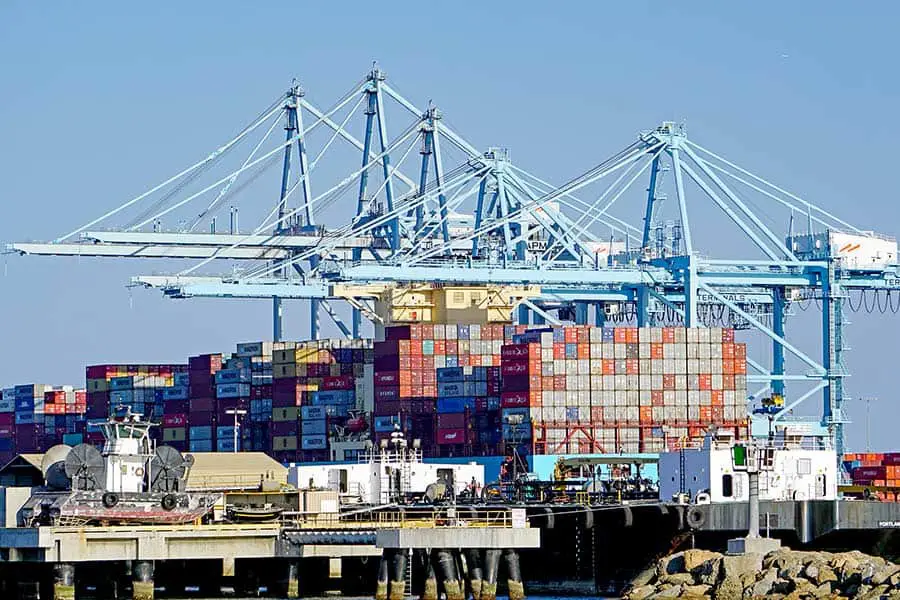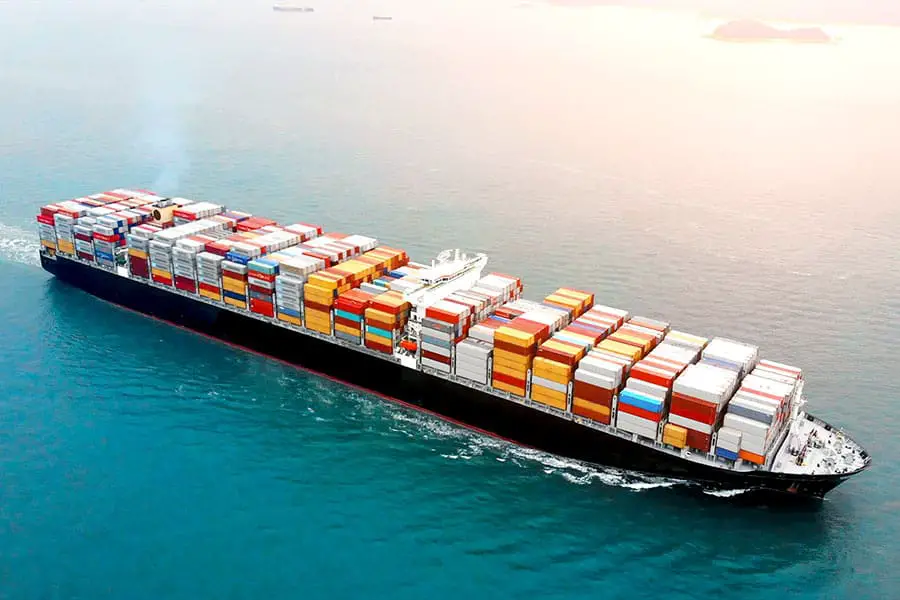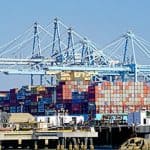
California is home to roughly 12 percent of the US population. With access to shipping lanes from Asia and the Panama Canal, its position on the Pacific coast makes it the perfect location for major port operations. In fact, nearly half of all shipping containers make their way through the ports of Southern California. The two largest ports are the Port of Los Angeles and the Long Beach Port. So, which port is bigger?
The Port of Los Angeles is larger than Long Beach Port based on both its size and the volume of cargo that passes through it each year. However, it’s important to note that Long Beach Port is a close second.
These two ports are often confused because they are adjacent to each other. Continue reading to learn more about their history, who owns and operates this vital infrastructure, and the economic benefit that is generated each year.
LA or Long Beach: Which has the Bigger Port?
The Cities of San Francisco and San Diego both benefit from large natural harbors that make them ideal locations for shipping ports. The City of Los Angeles, on the other hand, has no such harbor.
For this reason, several competing ports opened up, including Los Angeles, Long Beach, and Santa Monica. But unfortunately, the plans to build the port at Santa Monica failed to get local support.
On the other hand, Long Beach and Los Angeles ports got the support they needed to continue growing. The primary reason for keeping the two ports separated was that the land used by the ports belonged to two separate cities.
The Port of Los Angeles is the larger of the two ports. Ranked as the largest port in the United States, operations for Los Angeles cover 7,500 acres with access to 43 miles of waterfront. With a depth of 53 feet, the port can handle the largest cargo ships in the world.
The surrounding port operations include 25 cargo terminals (the place where cargo or passengers are loaded or unloaded), 83 container cranes, and 116 miles of railway. Each year, the port processes about 10 million TEUs (Twenty-Foot-Equivalent-Unit or 20′ x 8′ x 8′) delivered by nearly 1,700 vessels.

While the Long Beach Port is technically smaller than the Port of Los Angeles, it is still a massive operation on its own. By itself, Long Beach Port is the second largest port in the United States and even ranks in the world’s top 20 busiest ports.
The operations at Long Beach Port cover about half the area of the Port of Los Angeles (3,500 acres with 25 miles of waterfront). The port employs more than 300,000 people in Southern California and has seven main terminals and 72 container cranes. Long Beach port can also handle the largest cargo ships with a water depth of 50 feet.

Both ports have cruise ship terminals — San Pedro World Cruise Center (Los Angeles) and Long Beach Cruise Terminal. However, the number of cruise ships that dock at the ports has decreased significantly in recent years. At a peak in 2008, cruise ships made 265 stops here, carrying nearly 1.2 million passengers.
Over the last decade, the number has dropped to about 100 stops with around 500,000 passengers annually. This decrease has been a combination of economic impacts from the Great Recession, rising violence in Mexico, where California cruise ships often made stops, and increased competition from other West Coast cruise ship ports (San Diego, San Francisco, and Seattle).
Bay Area Answers Fun Fact: About 40% of all container cargo entering the United States comes through the ports of Long Beach and Los Angeles. Combined, they would make up the 9th largest port in the world.
Other Posts of Interest
- Is It Illegal To Collect Rainwater In California?
- What Is The Purpose Of Coit Tower?
- Are Cara Cara Oranges and Blood Oranges the Same?
- What Is The Largest Bay In California?
Is the Port of LA and Long Beach the Same?
The ports of Los Angeles and Long Beach are often confused with one another. Part of the problem is their extremely close proximity. Both ports are adjacent to each other and share some of the same waterways.
Despite being operated individually and owned by each city’s government, they are often viewed as one shipping operation, collectively known as the San Pedro Bay Port Complex. So, for example, if you ask a local where they are getting on their cruise ship, they will often respond with “San Pedro” (even though the ship could be leaving from a terminal at either port).
Who Owns the Port of Los Angeles and Long Beach?
The details can get a bit confusing when it comes to port ownership. Officially the ports of Los Angeles and Long Beach are owned and governed by the respective cities. For example, the Port of Los Angles is governed by the Los Angeles Board of Harbor Commissioners, a panel appointed by the Mayor of Los Angeles.
However, many of the surrounding port terminals and cargo facilities are privately owned and operated by various corporations. For many years, a Chinese state-owned company (Orient Overseas International Ltd. or OOIL) owned a large percentage of the private operations at both Long Beach Port and the Port of Los Angeles.
In 2017, COSCO (China Ocean Shipping Company) purchased OOIL and took over its operations. However, this transaction caught the US government’s attention, and they pressured COSCO to sell its operations to a North American-based subsidiary of Macquarie Infrastructure and Real Assets for $1.78 billion.
What Kind of Cargo Goes Through the Port of Los Angeles?
The Port of Los Angeles processes over $250 billion worth of cargo each year. The top five imports include furniture, auto parts, apparel, plastics, and footwear.
The majority of these goods come from major shipping partners, including China, Japan, Vietnam, Taiwan, and South Korea.
In addition to imports, the Port of Los Angeles exports many goods which are primarily destined for Asia or Europe. The top exports include pet and animal feed, wastepaper, soybeans, fabrics, raw cotton, and scrap metal.

How Much Money Does the Port of Los Angeles Generate?
The Port of Los Angeles makes money from shipping activities, including vessel servicing, facility fees, and leasing land for commercial or industrial uses. Annually, the gross operating revenue is over $500 million.
Half ($275 million) of this revenue is used to fund and run port operations. The remaining money is used to help pay for capital improvements at the port, such as renovations and the installation of new infrastructure or equipment.
How Important is the Port of Los Angeles?
The Port of Los Angeles is the largest port in the United States. About 16 percent of all the goods and food shipped into the United States passes through its harbor.
In addition to being a significant lifeline to connect the United States to the global economy, the port is responsible for the creation of millions of jobs.
It’s estimated that 134,000 people in Los Angeles are employed both directly and indirectly by operations at the port. Nationally, the Port of Los Angeles is estimated to sustain about 1.4 million jobs.
What Type of Cargo Goes Through Long Beach Port?
Most of the cargo (approximately 90%) that comes through Long Beach Port comes from East Asia. The top trading partners include China, Vietnam, South Korea, Japan, Hong Kong, and Taiwan.
The largest imports include crude oil, electronics, plastics, furniture, and clothing destined for mostly US-based locations. Conversely, the top exports through Long Beach Port include petroleum, chemicals, waste paper, and food.

How Many Containers Does a Cargo Ship Hold?
Container cargo ships are massive. Depending on the size of the ship, most cargo vessels can hold between 10,000 to 21,000 TEUs (approximately 20′ long x 8′ wide x 8′ high). The largest container ships in the world can handle about 24,000 TEUs!
There are actually four identical ships owned by the Taiwanese shipping company, Evergreen, which holds the current size record. These ships (named Ever Ace, Ever Act, Ever Aim, and Ever Alp) are over 1,300 feet long.
Shipping Powerhouse of the Golden Coast
Although the Port of Los Angeles takes the title of largest port, the economy of California and the United States rely heavily on the combined efforts of both ports. Without this vital infrastructure, millions of jobs would be lost, and trade between the growing economies of Asia would be much more difficult. So the next time you purchase an imported product at the store, stop and consider the impressive journey that it likely made through one of these busy ports.





